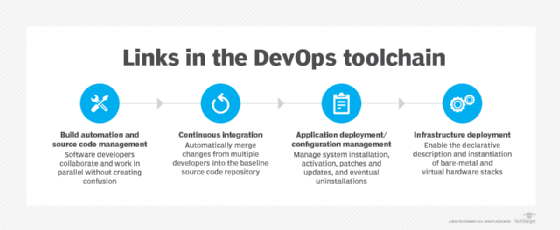
freshidea - Fotolia
Craft a DevOps transformation roadmap around these 5 milestones
As organizations embark on a DevOps journey, they can use these five milestones to ensure team members stay on track -- and collaborate efficiently along the way.
Authoring a DevOps transformation roadmap is both a tactical and strategic exercise. Organizations must chart a course with concrete milestones that reflect business and technology goals.
Beyond the day-to-day process changes, DevOps makes an organization more agile in its response to an evolving market. The iterative security testing that occurs as part of a DevOps initiative also helps organizations reach compliance goals.
However, a shift to DevOps -- as well as the ability to gauge the success and progress of that shift -- requires a formal plan. And it takes more than a PowerPoint deck with multicolor graphics to communicate that plan effectively to business, security and technical stakeholders.
While the details of a DevOps transformation roadmap will vary between organizations, consider these five milestones to define and measure progress toward a DevOps culture.
1. The kickoff project
A DevOps transformation won't be turnkey. Start with a small pilot project that lets admins iterate on management, automation, collaboration and delivery processes with minimal disruption to the business.
For the first project, aim to learn the DevOps process and collect continuous feedback from the team members involved. While it is tempting to use an internal company project as the first DevOps effort, tie some budget dollars to the project to encourage people at all levels to take the transformation seriously.
2. The start of shared decision-making
This milestone on a DevOps transformation roadmap is where shared decision-making between stakeholders and developers begins. It's also where teams make improvements to managed communication and collaboration between the development and operations teams.
Work begins to evolve from siloed automation to more centralized infrastructure automation. However, processes are not yet standardized across the organization.
Team leads and other managers might need to work with their teams during this phase to facilitate collaboration and to serve as mentors during decision-making. Some managers might have to adjust their management style to accommodate these needs.
3. Refined collaboration and standardization
At this milestone, teams begin to experience DevOps maturity. Tools and processes are in place to support full collaboration between development, operations and business stakeholders. The processes, data, communication practices and relationships begin to fall into place to solidify shared decision-making and accountability. Any vestiges of top-down command and control in the development organization should be gone by this milestone.
Another sign of a mature DevOps organization is the application of automated processes across the delivery life cycle. These automation efforts should build upon the work required to meet the previous two milestones. Business units must collaborate to standardize processes across the organization, so everybody works from the same DevOps playbook. This will require both documentation and internal training.
Focus on embedding knowledge into the DevOps toolchain. For example, consider just-in-time training, or bring in technical writers to document processes and tools, then publish the documentation to a centralized repository. Another option is to send team members to cloud or DevOps vendor certification training.
Who drives transformation?
Support for DevOps should come from all levels of the company -- from front-line developers to the C-suite -level.
Development leads and their teams should have goals to improve delivery, collaboration and feedback. Depending on the corporate culture, organizations can struggle to meet collaboration goals, in particular. Appoint DevOps champions across the company to sell efforts to business and technology staff.
The CISO and CIO could gain a security edge as they move from Waterfall to DevOps, as the latter enables system patching on an iterative basis. They also gain more insight into the security and compliance of the IT systems under their protection.
C-level, business development and corporate growth executives want to expand the company's business and make more money to better serve their shareholders and customers. DevOps gives them a tool to shorten release cycles, and arms sales executives with tools and processes to deliver more features to customers.
4. The ability to measure progress
DevOps requires organizations to collect and analyze metrics that track progress toward operational and business goals. At this stage in a DevOps transformation roadmap, implement tools and processes to identify bottlenecks in the software delivery lifecycle. The purpose of this phase is to gain visibility and predictability over delivery to improve quality and performance.
Data collection and measurement also means allotting time in delivery processes to improve daily work. Goals during this phase should revolve around iterating on data capture and measurement from the DevOps toolchain. Beyond that, work to report to developers and stakeholders to ensure the right people get the actionable data they require.

5. Operations and continual optimization
At this stage of the DevOps journey, teams have reached a level of effective knowledge sharing. Team members feel empowered to make decisions. Tooling choices are in place. However, it's not a time to stop. Use this milestone to dedicate time and project tasks to continue to refine and optimize the DevOps lifecycle, operations and cybersecurity.






